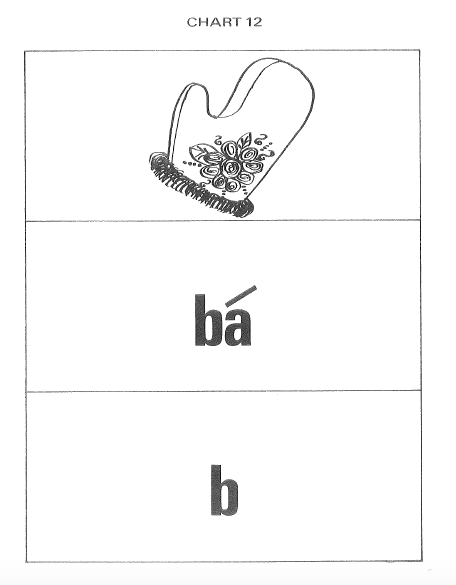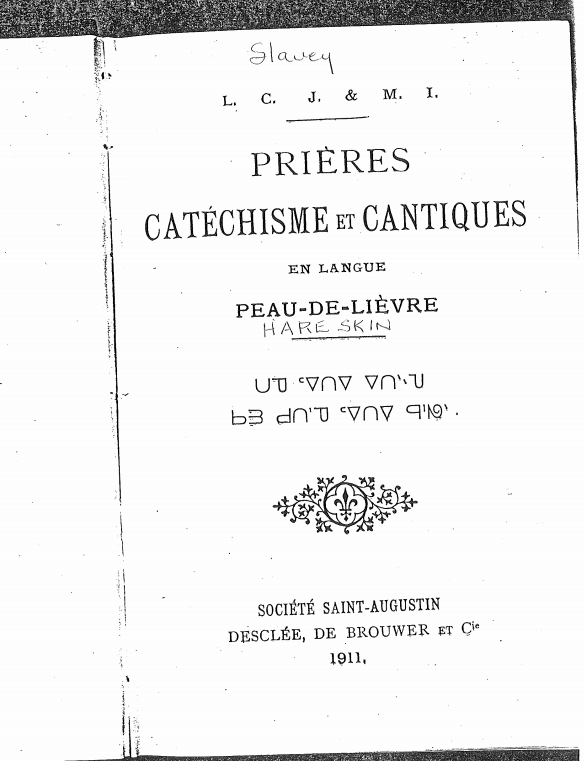Making Literacy in the Northern Dene Languages Functional
Chambers’ presentation provides valuable context for the work in curriculum development and written language documentation occurring in the early 1980s.
From the Introduction:
“Hello. My name is Cynthia Chambers. For the past two years I have been working with the Department of Education in Yellowknife, Northwest Territories in Canada, as a curriculum developer. The curriculum I have been developing has been in the northern Dene languages for use in the Territorial schools. A majority of my time has been spent in the preparation of materials for the Chief Jimmy Soldat School in Fort Franklin, N.W.T., which has been a pilot project for the use of a Dene Language as the language of instruction from kindergarten to grade two, since 1979. In conjunction with this work, I have been involved in numerous inservice training workshops with Dene classroom assistants (teacher aides) and teachers. These workshops have covered a number of topics including literacy training and methodology but most importantly what might be aptly coined as sociology of Dene bilingualism.
The various aspects of my work have, over the last two years, forced me to examine some of the issues in curriculum development in northern Dene languages. It is really a brief synopsis of my examination of these issues that I would like to share with you now.
Many of these issues have involved the disciplines of psychology and linguistics. The lack of hard core linguistic research data on early and middle year Dene language acquisition; as well as psychological research on the cognitive development, cognitive categories and strategies of Dene children have severely hampered our ability to develop program materials based on research evidence. Without such research we have no basis from which to develop an evaluation mechanism for either our first or second language programs. We have no evidence to indicate how effective our present programming has been and what areas require improvements or change. The dearth of research has meant that we have not even tried to develop a mechanism for testing children’s oral proficiency in the Dene languages; a tool we sorely need in so many of our schools where the school population has mixed proficiency in the Dene languages. We must know how well the children understand and speak the language before a program can be developed and they can be grouped for introduction. The general lack of scientific and applied research in all of these areas has hampered the development of effective Dene language programs. Because to date most of the curriculum development has been in the language arts area for a Dene as the Language of instruction [xxx], we have tried to apply modern reading theory to the development of a tertiary level literacy program."
Access this Resource:
This conference paper is held in the NWT Archives: accession no. 2007-14 (Cynthia Chambers Collection).
Chambers, Cynthia. “Making Literacy in the Northern Dene Languages Functional.” Arcata: Second Annual Athapaskan Linguistics Conference, 1981.
Sahtú Got’ine Gokedeé: A Slavey Language Pre-Primer in the Speech of Fort Franklin
This document consists of 45 charts; each one contains a picture, a word, and a sound within that word. For example, a picture of a frog, “ts’aleh,” then “ts’”.
Foreword: This is one of a series of experimental texts and learning units prepared for use in the Chief Jimm Soldat School in Fort Franklin. If this material works well there, we hope it can serve as a model for other teachers of Athapaskan languages elsewhere. We would be delighted to hear of it being used, adapted or even copied by other Athapaskan teachers. (S.T. Mallon, Linguistic Programmes Division, Department of Education, Northwest Territories).

Access this Resource:
Tatti, Fibbie, and Philip Howard. Sahtú Got’ine Gokedeé: A Slavey Language Pre-Primer in the Speech of Fort Franklin. Yellowknife: Northwest Territories Department of Education. Linguistic Programs Division, 1978.
Multilingualism of Natives in the Mackenzie District: An Analysis of data from the Northern Manpower Survey Program
The report assesses multilingualism for Indigenous peoples in the Mackenzie district using data from the 1970 Northern Manpower Survey Program, which was collected between 1969 and 1971 in the Northwest Territories and the Yukon. The authors identify six major language groups: “Dogrib, Slave, Chipewyan, Loucheux, Eskimo and English” (1). Survey respondents were 14 years of age or older, and the five questions on language use included; “language first learned as a child” (1); “language most often spoken at home” (1); and “up to three languages in each of the categories ‘currently spoken,’ ‘currently read,’ and ‘currently written’” (2). However, because “most of the indigenous languages cannot be formally written,” the authors did not use data on writing or speaking. It is important to note that communities had varying response rates, and rates were based on NWT government population estimates. A few key findings for Mackenzie native peoples:
“English unilingualism is highest in the 14-24 age group.” (7)
“Native language unilingualism drops off sharply by age group.” (7)
“The use of English is greatest among the Métis in the Mackeznie District. Only 1 percent speak only their native language. Roughly have speak a native language and English; the other 50 percent speak only English.” (7)
Dogrib, followed by "Slave," had the highest reported proportion of unilingual speakers (43% and 31%, respectively, table 2 p. 11).
At the time of the survey, over 81% of the Indigenous population of the NWT had some knowledge of English.
Access this Resource:
This document is available in the NWT Archives: Accession no. 2007-14 (Cynthia Chambers Collection).
Barrados, Maria, and Martha Burd Van Dine. Multilingualism of Natives in the Mackenzie District: An Analysis of data from the Northern Manpower Survey Program. Ottawa: Indian and Northern Affairs Canada, Northern Social Research Division, 1977.
A preliminary grammar of Fort Good Hope Slavey (Hare)
This document, along with Rice’s (1977) Hare Noun Dictionary, were based on fieldwork in Fort Good Hope in 1973, and contributed to the eventual publication of A Grammar of Slave.
Access this Resource:
Rice, Keren. A preliminary grammar of Fort Good Hope Slavey (Hare). Ottawa: Northern Social Research Division, Department of Indian and Northern Affairs, 1977.
A Note on the Hare Indian Color Terms Based on Brent Berlin and Paul Kay: Basic Color Terms. Their Universality and Evolution
Working in Fort Good Hope in the 1972-1973, Harald Broch interviewed Addy Tobac, Lucy Jackson, Georgina Tobac, and Pasanne Manuel. These informants provided him with a list of colour terms:
white, dεkɂal̨ε
black, dεsεn
red, dεdεlε
yellow, dεfↄ
green, ætʒ
blue, dεtłɂε
pınk, tsε
brown, dεsεn dεfↄ
[*note: the author’s spellings have simply been transcribed as written here]
Broch finds from his informants that red may be related to blood, and that pink, tsǝ, is also a word for sprucegum (which turns dark pink when chewed). Green also means grass, leaves, cabbage, and flowers. Blue, white, and black have no other meanings.
Access this Resource:
Read the full text on JSTOR: http://www.jstor.org/stable/30029410
Broch, Harald. “A Note on the Hare Indian Color Terms Based on Brent Berlin and Paul Kay: Basic Color Terms, Their University and Evolution.” Anthropological Linguistics 16, no. 5 (1974): 192-196.
Prières Catchésme et Cantiques en Langue Peau-De-Lièvre [Hareskin Syllabics]
This scanned document is a French guide to “Peau-De-Lièvre” (Dene/"Hareskin") syllabics. The devotional translations were contributed to by Audemard, Henri, 1864-1948; Ducot, Xavier, 1848-1916; Gouy, Édouard, 1869-1943; Petitot, Émile, 1838-1917; and Séguin, Jean, 1833-1902. Petitot wrote a significant body of work about his time in the Sahtú region - search his name in this database to find more of his writings.

Access this Resource:
Read the full text online.
Prières Catchésme et Cantiques en Langue Peau-De-Lièvre [Hareskin Syllabics]. Société Saint-Augustin, Desclée, De Brouwer. 1911.
Dictionnaire de la langue Dènè-Dindjié, dialects Montagnais our Chippewayan, Peaux de lièvre et loucheux, etc.
This was the first extensive dictionary of northern Athapaskan languages, and it includes Sahtú varieties. Émile-Fortuné Petitot was a French oblate missionary, who worked in the Athabasca-Mackenzie area of what is now the Northwest Territories during 1862-1883. There is also a version published in San Francisco by A.L. Bancroft (also 1876).
Access this Resource:
Petitot, Émile. Dictionnaire de la langue Dènè-Dindjié, dialects Montagnais our Chippewayan, Peaux de lièvre et loucheux, etc. Paris: E. Leroux, San Francisco: A.L. Bancroft, 1876.
Read the full text online from the Internet Archive:


 Phone: 867-374-4040
Phone: 867-374-4040 Email:
Email: